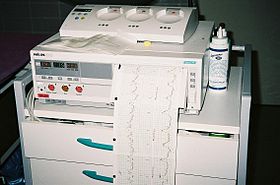Fetal heart rate
| Cardiotocography | |
|---|---|
| Intervention | |

A cardiotocograph recording fetal heart rate and uterine contractions
|
|
| ICD-9-CM | 75.32 |
| MeSH | D015148 |
Cardiotocography (CTG) is a technical means of recording the fetal heartbeat and the uterine contractions during pregnancy. The machine used to perform the monitoring is called a cardiotocograph, more commonly known as an electronic fetal monitor (EFM).
Fetal monitoring was invented by Doctors Alan Bradfield, Orvan Hess and Edward Hon. A refined (antepartal, non-invasive, beat-to-beat) version (cardiotocograph) was later developed for Hewlett Packard by Konrad Hammacher.
CTG monitoring is widely used to assess fetal wellbeing. A review found that in the antenatal period (before labour) there is no evidence to suggest that monitoring women with high-risk pregnancies benefits the mother or baby although research around this is old and should be interpreted with caution. The same review found that computerised CTG machines resulted in lower numbers of baby deaths than the traditional CTG machines (as shown in picture). More up-to-date research is needed to provide more information around this practice.
CTG monitoring can sometimes lead to medical interventions which are not necessarily needed. Fetal vibroacoustic stimulation (sound played to the unborn baby through the mother’s abdomen) has been used to provoke the baby into being more active. This can improve their CTG monitoring so that the mother does not have to be monitored for as long. However the safety of this technique has not been fully assessed; hearing impairment, stress reactions and other effects should be investigated before this technique is used widely.
External cardiotocography can be used for continuous or intermittent monitoring. The fetal heart rate and the activity of the uterine muscle are detected by two transducers placed on the mother’s abdomen (one above the fetal heart, to monitor heart rate and the other at the fundus of the uterus to measure frequency of contractions). Doppler ultrasound provides the information which is recorded on a paper strip known as a cardiotocograph (CTG). External tocometry is useful in showing the beginning and end of contractions, as well as frequency, but not the strength of contractions. The absolute values of pressure readings on an external tocometer are dependent on position, and are not sensitive in people who are obese. In cases where information on the strength, or precise timing, of contractions is needed, an internal tocometer is more appropriate.
...
Wikipedia
